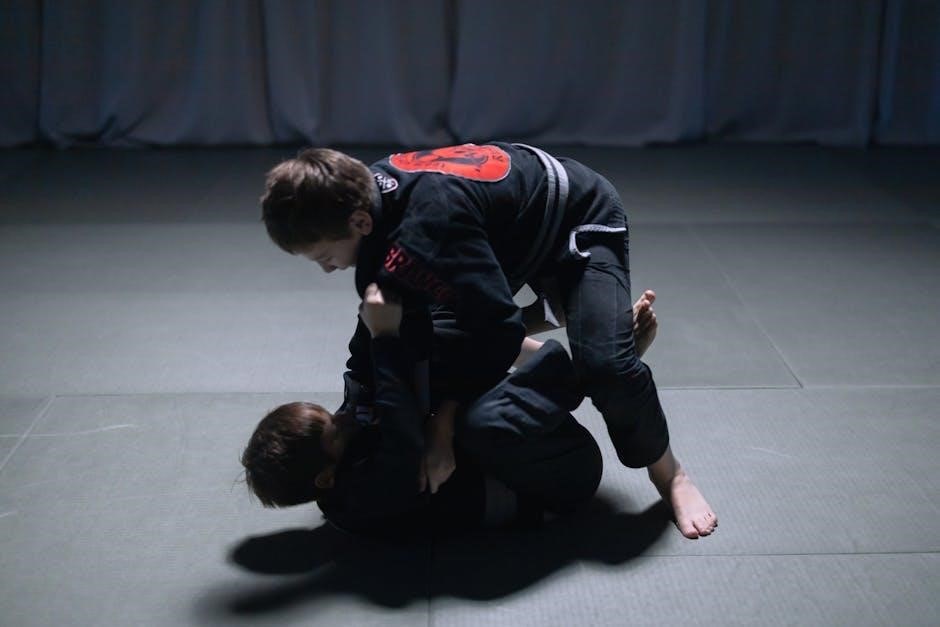The 54321 Grounding Technique is a mindfulness tool that helps individuals focus on the present moment by engaging all five senses. It’s simple‚ effective‚ and accessible‚ making it a popular choice for reducing anxiety and stress in overwhelming situations. By systematically identifying things you can see‚ touch‚ hear‚ smell‚ and taste‚ this technique grounds you in reality‚ offering quick relief and clarity. It’s widely used in therapy and everyday life to promote calm and emotional regulation‚ especially during moments of distress or trauma recovery.
Overview of Grounding Techniques
Grounding techniques are practical strategies designed to help individuals focus on the present moment‚ reducing anxiety‚ stress‚ or dissociation. These methods often involve engaging the senses to reconnect with reality. They are widely used in therapy and everyday life to promote emotional regulation and calm. Grounding techniques can vary‚ ranging from deep breathing exercises to sensory-focused activities like the 54321 technique. They are adaptable to different environments‚ making them accessible for use in various situations. By anchoring the mind in the here and now‚ grounding techniques provide a quick‚ effective way to manage overwhelming emotions and regain control over one’s mental state.
The Significance of the 5-4-3-2-1 Method
The 5-4-3-2-1 method stands out as a structured and memorable grounding technique‚ offering a clear framework to engage all five senses. Its simplicity makes it accessible to anyone‚ regardless of their background or situation. By starting with larger sensory inputs (five things seen) and narrowing down to smaller‚ more intimate ones (one thing tasted)‚ the method creates a gradual shift in focus‚ anchoring the individual in the present. This structured approach helps break through overwhelming emotions‚ providing a sense of control and calm. Its effectiveness lies in its ability to distract from distressing thoughts while fostering mindfulness‚ making it a powerful tool for emotional regulation.

History and Development of the 54321 Technique
The 54321 Grounding Technique originated from sensory grounding practices‚ evolving into a structured method to help individuals focus on the present. Its development emphasized simplicity and accessibility‚ making it a widely recognized tool for emotional regulation and stress relief.
Origins of Sensory Grounding Practices
Sensory grounding practices have roots in mindfulness and therapeutic techniques aimed at bringing individuals back to the present moment. These methods emphasize using the senses to anchor awareness‚ reducing anxiety and stress. The 54321 technique emerged as a structured approach within this framework‚ guiding users to identify stimuli in their environment systematically. By focusing on tangible elements—sights‚ sounds‚ textures‚ smells‚ and tastes—it helps individuals regain emotional balance. This practice is widely used in mental health and trauma recovery‚ offering a simple yet effective tool for grounding in overwhelming situations. Its popularity stems from its accessibility and universal applicability in various settings.
Evolution of the 54321 Grounding Exercise
The 54321 Grounding Exercise evolved from broader mindfulness practices‚ adapting traditional sensory techniques into a structured‚ easy-to-follow method. Initially used in clinical settings to aid trauma recovery‚ it gained popularity as a universal tool for stress relief. Over time‚ its accessibility and effectiveness led to widespread adoption in both therapeutic and everyday contexts. The technique’s clear‚ step-by-step approach makes it adaptable across various environments‚ from classrooms to workplaces. Its evolution reflects the growing need for practical mental health strategies‚ ensuring its relevance in modern‚ fast-paced lifestyles. This grounding exercise continues to be a valuable resource for fostering emotional resilience and calm.

Core Elements of the 54321 Grounding Technique
The technique involves identifying 5 things seen‚ 4 touched‚ 3 heard‚ 2 smelled‚ and 1 tasted. This structured sensory engagement helps ground individuals in the present moment.
5 Things You Can See

The first step in the 54321 Grounding Technique involves identifying five things you can see around you. These could be objects‚ colors‚ patterns‚ or even small details like a spot on the wall or the texture of a rug. The goal is to focus on your visual environment to anchor yourself in the present moment. This step helps distract from overwhelming thoughts and begins the process of grounding. By actively engaging with what you see‚ you create a mental shift away from anxiety and toward awareness. This simple yet effective practice sets the foundation for the rest of the technique.
4 Things You Can Touch
The next step in the 54321 Grounding Technique involves identifying four things you can touch. This could include the feeling of your feet on the ground‚ the texture of a nearby object‚ the sensation of the air on your skin‚ or the weight of something in your hand. Touching physical objects helps anchor you in the present moment by engaging your sense of tactile awareness. This step builds on the previous one‚ deepening your connection to your surroundings and further reducing feelings of anxiety or disconnection. By focusing on tangible sensations‚ you create a stronger sense of grounding and stability.
3 Things You Can Hear
The third step in the 54321 Grounding Technique involves identifying three things you can hear. This could include ambient sounds like birds chirping‚ traffic noise‚ or the hum of a fan. It might also involve closer‚ more subtle sounds‚ such as your own breathing or the rustle of clothing. Focusing on auditory cues helps deepen your connection to the present moment by engaging another layer of sensory awareness. This step encourages mindfulness and distraction from overwhelming thoughts‚ further grounding you in your environment. By listening intentionally‚ you enhance your ability to stay calm and centered‚ even in chaotic situations.
2 Things You Can Smell
The fourth step in the 54321 Grounding Technique asks you to identify two things you can smell. This could be the scent of fresh coffee brewing‚ the aroma of flowers‚ or even the subtle smell of clean air. Engaging your sense of smell helps anchor you in the present moment by introducing another layer of sensory input. Smells often evoke strong emotional responses‚ making this step particularly effective for grounding. Whether it’s a familiar fragrance or a neutral odor‚ focusing on what you can smell distracts your mind from anxious thoughts and brings you closer to your surroundings‚ enhancing calm and clarity.
1 Thing You Can Taste
The final step in the 54321 Grounding Technique involves identifying one thing you can taste. This could be a piece of gum‚ a sip of coffee‚ or even the subtle flavor of fresh air. Focusing on taste grounds you in the present moment by engaging your senses fully. It’s a powerful way to redirect your attention away from stressful thoughts. Whether it’s a familiar flavor or something new‚ tasting something tangible helps calm your mind and body‚ reinforcing your connection to the here and now. This step completes the sensory journey‚ leaving you feeling centered and more in control.

Benefits of the 54321 Grounding Technique
The 54321 technique reduces anxiety and stress by focusing on the present‚ improving emotional regulation. It enhances focus‚ aids in trauma recovery‚ and promotes mental clarity‚ offering quick‚ accessible relief for overwhelming situations. Regular practice boosts overall well-being and resilience‚ making it a valuable tool for managing daily stress and emotional challenges.
Reducing Anxiety and Stress
The 54321 grounding technique is highly effective in reducing anxiety and stress by anchoring the mind in the present moment. By focusing on sensory experiences—such as identifying five things you can see or four things you can touch—it distracts from overwhelming thoughts and emotions. This method interrupts the cycle of anxiety‚ providing immediate relief and calm. The technique is particularly useful during panic attacks or stressful situations‚ as it shifts focus from internal distress to external stimuli. Its simplicity and accessibility make it a powerful tool for managing anxiety anywhere‚ without requiring any special equipment or preparation.
Improving Focus and Presence
The 54321 grounding technique enhances focus and presence by engaging the senses‚ pulling the mind back to the current moment. By systematically identifying sensory details—such as five things seen‚ four touched‚ or three heard—it quiets the mind and reduces mental chatter. This practice fosters clarity and concentration‚ making it easier to stay present. Regular use improves the ability to anchor oneself in reality‚ enhancing overall mindfulness. The technique is especially useful in noisy or distracting environments‚ helping individuals maintain focus and composure. Its simplicity makes it a practical tool for improving presence in both daily life and challenging situations.
Helping with Trauma Recovery
The 54321 grounding technique is a valuable tool in trauma recovery‚ offering a safe way to reconnect with the present moment. For individuals experiencing flashbacks or dissociation‚ this method helps reduce feelings of disconnection by focusing on sensory experiences. By identifying specific elements in their environment—sights‚ sounds‚ textures‚ smells‚ and tastes—individuals can anchor themselves in reality. This technique provides a sense of control and stability‚ which is crucial for managing post-traumatic stress. Regular practice can help diminish the intensity of traumatic memories and reduce anxiety‚ fostering a sense of calm and grounding during difficult moments. It’s a simple yet effective strategy for healing and resilience.

How to Practice the 54321 Grounding Technique
Notice 5 things you can see‚
4 things you can touch‚
3 things you can hear‚
2 things you can smell‚
and 1 thing you can taste.
Step-by-Step Instructions
Start by identifying 5 things you can see around you‚ such as objects‚ colors‚ or patterns.
Next‚ notice 4 things you can touch‚ like textures‚ sensations‚ or items within reach.
Then‚ listen for 3 things you can hear‚ focusing on distinct sounds nearby.
After that‚ identify 2 things you can smell‚ whether subtle or strong.
Finally‚ recognize 1 thing you can taste‚ like a piece of gum or a sip of water.
This process helps anchor you in the present moment‚ reducing anxiety and stress effectively.
Preparation and Mindset
Before practicing the 54321 Grounding Technique‚ adopt a calm and intentional mindset. Find a comfortable position‚ either sitting or standing‚ and take a deep breath to center yourself. Ensure you are in a safe environment where you can focus without distractions. Grounding techniques work best when you fully engage your senses‚ so approach the exercise with curiosity and openness. There’s no need for special tools or preparation—just your awareness and willingness to connect with the present moment. Regular practice enhances its effectiveness‚ making it a reliable tool for managing stress and anxiety whenever needed.

When and Where to Use the 54321 Technique
The 54321 Grounding Technique is versatile and can be used anytime‚ anywhere. It’s especially effective during anxiety attacks‚ overwhelming environments‚ or moments of emotional distress to quickly regain calm and focus.

Situations for Grounding
The 54321 Grounding Technique is most effective in situations where individuals feel overwhelmed‚ anxious‚ or disconnected from their surroundings. Common scenarios include during anxiety attacks‚ in loud or crowded spaces‚ or when experiencing emotional distress. It’s also useful in moments of panic‚ such as public places‚ personal conflicts‚ or stressful events. Additionally‚ it can be applied during quiet moments of reflection to enhance mindfulness. The technique’s simplicity makes it adaptable to any environment‚ whether at home‚ work‚ or in nature. By focusing on sensory inputs‚ it helps ground individuals in the present‚ providing immediate relief and clarity in challenging situations.
Adapting the Technique for Different Environments
The 54321 Grounding Technique can be easily adapted to suit various environments‚ making it versatile for different situations. In public places‚ focus on subtle sensory observations to avoid drawing attention. At home‚ incorporate familiar sights‚ sounds‚ and smells for comfort. In nature‚ emphasize the abundance of sensory stimuli‚ such as the sounds of birds or the scent of plants. Even in noisy or crowded spaces‚ the technique can be practiced discreetly by focusing on personal sensory experiences. Its adaptability ensures it remains effective regardless of where it is used‚ whether in quiet reflection or chaotic surroundings‚ helping to restore balance and calm.

Frequently Asked Questions (FAQs)
Is the 54321 Technique Suitable for Everyone?
Yes‚ the 54321 Grounding Technique is generally suitable for everyone‚ including children and individuals with diverse needs‚ as it is a simple‚ non-invasive sensory exercise.
How Long Does It Take to See Results?
Results can be immediate for some‚ while others may need consistent practice to experience the full benefits of grounding and reduced anxiety or stress.
Is the 54321 Technique Suitable for Everyone?
The 54321 Grounding Technique is universally accessible and can be adapted for various individuals‚ including children‚ adults‚ and those with special needs. Its simplicity makes it an excellent tool for anyone seeking to manage stress or anxiety in the moment. While generally safe‚ individuals with severe trauma or sensory sensitivities may benefit from practicing it with a trained professional or in a comfortable environment. The technique’s non-invasive nature ensures it can be used almost anywhere‚ making it a versatile option for emotional regulation and grounding. Regular practice enhances its effectiveness for many users.
How Long Does It Take to See Results?
Results from the 54321 Grounding Technique can often be felt immediately‚ as it quickly shifts focus to the present moment. Many users report reduced anxiety and increased calm within minutes of practicing the exercise. Consistent practice enhances its effectiveness‚ improving emotional resilience and focus over time. While some individuals may experience benefits after a single session‚ others may need a few attempts to feel the full impact; Patience and regular use are key to maximizing its grounding effects and achieving long-term emotional regulation. The technique’s simplicity allows for quick integration into daily life‚ making it a practical tool for ongoing well-being.

Variations and Adaptations of the 54321 Technique
The 54321 Grounding Technique can be adapted to various environments and needs‚ offering flexibility for different situations. It can be modified to suit sensory sensitivities or specific conditions‚ such as trauma recovery‚ by adjusting the focus on certain senses or incorporating additional mindfulness practices. This adaptability makes it a versatile tool for grounding in diverse settings‚ ensuring its effectiveness for individuals with unique requirements or preferences. Its core structure remains simple‚ yet its applications can be tailored to enhance personal comfort and efficacy.
Modified Versions for Specific Needs
The 54321 Grounding Technique can be tailored to suit individual needs‚ making it adaptable for diverse situations. For example‚ individuals with sensory sensitivities may focus on fewer stimuli or skip certain senses. In trauma recovery‚ the technique can be slowed down to prevent overwhelm. Some versions incorporate creative elements‚ like drawing or journaling‚ to enhance engagement. For children‚ the method can be simplified using age-appropriate language. Additionally‚ variations for specific environments‚ such as noisy or confined spaces‚ adjust the focus to what is most accessible. These modifications ensure the technique remains effective while addressing unique preferences or challenges‚ offering personalized grounding experiences.
Cultural and Individual Variations
Cultural and individual backgrounds influence how the 54321 Grounding Technique is practiced. In some cultures‚ the emphasis might be on collective harmony‚ while others focus on personal calm. Variations include incorporating local sensory cues‚ such as traditional music or natural elements. For instance‚ in urban settings‚ the technique might prioritize sounds and sights of the city‚ whereas in nature‚ it leans on environmental stimuli. Personal preferences also play a role‚ with some individuals favoring specific senses over others. These adaptions ensure the technique resonates deeply‚ making it universally applicable while respecting diverse experiences and contexts‚ thus enhancing its effectiveness for emotional regulation and stress relief across different populations and environments;
The 54321 Grounding Technique offers a simple yet powerful way to manage stress and anxiety by reconnecting with the present moment through sensory awareness. Its versatility makes it a valuable tool for emotional well-being‚ accessible to everyone‚ regardless of their circumstances. Regular practice can lead to greater calm‚ clarity‚ and resilience‚ making it an enduring technique for mental health and self-care. Embrace this method to find peace in life’s challenging moments‚ fostering a deeper connection to yourself and your surroundings. It’s a timeless approach to mindfulness that continues to empower individuals worldwide.
Final Thoughts on the 54321 Grounding Technique
The 54321 Grounding Technique is a transformative tool for managing stress‚ anxiety‚ and overwhelming emotions. By focusing on sensory experiences‚ it provides immediate relief and fosters mindfulness. Its simplicity makes it accessible to everyone‚ regardless of age or situation. Whether in a quiet room or a bustling environment‚ this technique offers a reliable way to anchor oneself in the present. It’s not just a method for crisis moments but also a daily practice to enhance emotional resilience. Many find it empowering‚ as it shifts focus from internal turmoil to external stability. Embrace this technique to cultivate calm‚ clarity‚ and a deeper connection to your surroundings.
Encouragement to Practice and Share
Embrace the 54321 Grounding Technique as a simple yet powerful tool for mental well-being. Regular practice can lead to lasting calm and resilience. Share this technique with others‚ as it has the potential to positively impact lives. By spreading awareness‚ you contribute to a community focused on mindfulness and emotional health. Encourage others to explore this method‚ especially those struggling with anxiety or stress. Together‚ we can create a supportive environment where grounding techniques are widely understood and utilized. Your experience could inspire someone else to find peace and stability in their daily life.

